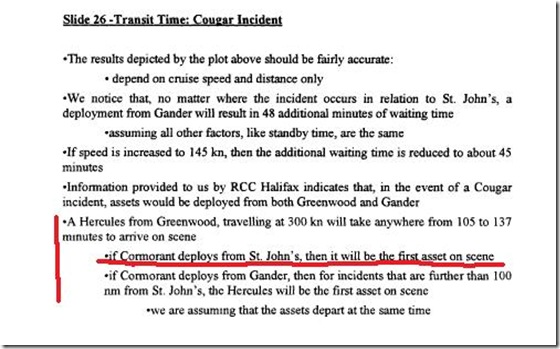A 2003 report by the Canadian Forces’ operational research and analysis centre concluded that “the coverage offered by Gander is better than that offered by St. John’s at all distances. Moreover there are notable differences at 400 and 500 nautical miles (nm) where the coverage given by Gander is better by 20 and 15 percent respectively.” (p. vi)
The report is available online at the DND operational research and analysis website. It provides a detailed analysis of search and rescue issues and assesses the relative merits of using St. John’s as a primary operating base for SAR helicopters compared to Gander.
The 2003 report concludes that - based on all factors including weather and the likelihood of Cougar helicopter incidents - Gander is preferable overall. The existing location provides optimum coverage across the entire range of potential missions, including any involving oil industry helicopters.
The report makes no observations on deploying helicopters to St. John’s (as opposed to basing), on the use of civilian search and rescue as currently provided by Cougar Helicopters under contract to the oil companies or on other ways to enhance overall SAR capabilities.
But the 2003 study clearly rejects the idea of moving DND SAR helicopters to St. John’s.
A careful reading of the report also suggests that under certain circumstances weather conditions at St. John’s might also erase any time advantage St. John’s would have at incidents less than 100 nautical miles from shore.
Since Monday, CBC St. John’s has been presenting an entirely different – and wrong - version of the DND report on east Coast search and rescue. An online story uses the title “St. John's best SAR base for offshore oil: DND” for example and uses a December 2000 presentation apparently obtained through the federal access to information laws.
Bond Papers discussed that initial CBC report story - and it’s inaccuracies - on Monday. The conclusion CBC claims the 2000 presentation reached is especially important since the later (2003) study used more data to develop a better picture of east coast search and rescue operations and the requirements posed by offshore oil operations.
But even given that, the initial review clearly concluded that :
While the modelling used in the report appeared to show St. John’s as a better location for what it terms “Cougar-related” incidents, “since incident rates for Cougar will probably be quite small, the analysis performed on the historic data should prove greater utility in a direct comparison of Gander with St. John’s.”
CBC has been linking to a December 2000 slide show that represented an early version of the work leading up to the 2003 study. A note at the end of the 2000 presentation – erroneously labelled ‘2003 report on SAR’ in the CBC’s pdf – indicates that a detailed report will follow in 2001.
It was actually published in 2003, as confirmed by a simple e-mail request to the operational research and analysis communications officer. For some reason, CBC hasn’t referred to the actual report, preferring instead to quote – and in some instances misquote - the 2000 slide show.
Your humble e-scribbler found the e-mail address for the operational research and analysis division on line and fired off an e-mail request for the later detailed report. A link to the publicly accessible database of reports and the title of the 2003 study came back within a few hours.
A second CBC story based on the same December 2000 pdf file also mashes sentences to create a completely false impression of what the 2000 presentation said. In a story on reaction to CBC’s initial reports titled “Renewed call for rescue base in St. John's”, there is this paragraph:
"For a Cougar [offshore oil industry helicopter] incident … if a Cormorant deploys from St. John's, then it will be the first asset on the scene," concluded the report, obtained by CBC News through an access to information request. "Deployment from Gander will result in 48 minutes of additional waiting time."
The actual information comes from a specific slide (number 26) discussing hypothetical Cougar helicopter incidents. It involves a comparison of flying a helicopter from Newfoundland versus flying a CC-130 fixed wing transport - with a higher flying speed than a helicopter– from Greenwood, Nova Scotia. Both aircraft would be deployed to a SAR incident involving a Cougar helicopter.
As can be easily seen, CBC lifts out the first bullet in the last section. The whole citation notes that for distances greater than 100 nautical miles, the Hercules would be the first one the scene. That’s hardly surprising given the relative speeds of the two aircraft over the distances involved in the DND projections.
The sentence mash-up conveys entirely incorrect and ultimately misleading information about the 2000 presentation and what it said.
It isn’t clear why the CBC stories have been persistently misrepresenting the DND report, but there is no question that CBC has twisted the DND reports to give conclusions the reports didn’t reach.
-srbp-
Related:
April 2009: “Continuing the Cougar S-92 Spin: CBC or Cougar”
October 2009: “When it comes to reckless speculation”
